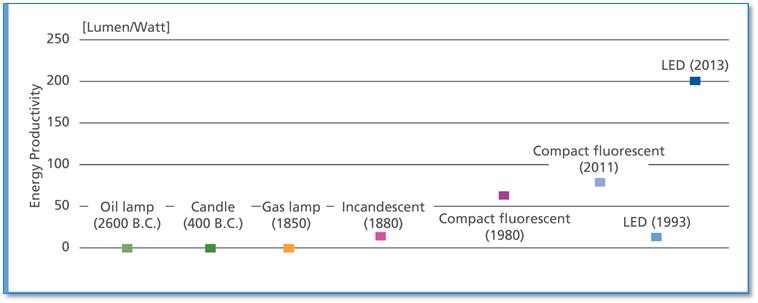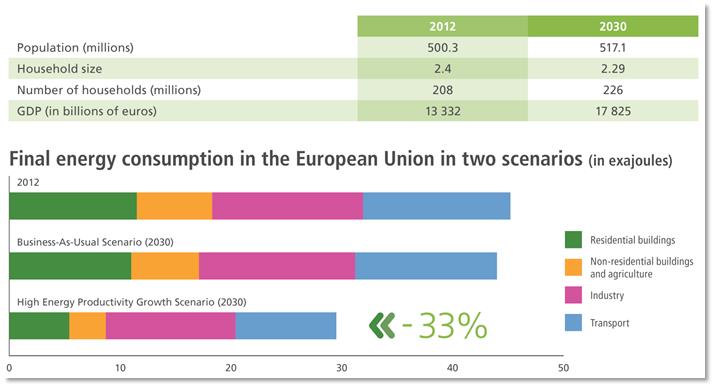Future can be far more efficient if we only adopted superior existing technology
Improving energy productivity – getting more output from each unit of energy input – has long been recognized as a sensible thing to do. A recent report by ECOFYS documents just how sensible it can be in driving economic growth, creating jobs and spreading well-being. It concludes, among other things, that “all regions of the world can improve their energy productivity performance dramatically based on more aggressive adoption of existing technology.”
Among its key findings is that:
“Regulators must be prepared to deploy an arsenal of tools, including mandating high energy-efficiency standards in automobiles, light bulbs, household appliances, refrigerators – and especially buildings. Improved labeling also helps by providing transparency on the energy choices consumers face when they make purchases.”
What would happen, for example, if “we could double the energy efficiency in houses we live,” it asks. The answer is “lower bills” as illustrated in the example for a typical European household on page 23. Multiply the average savings times roughly 200 million homes in Europe and the numbers are staggering.
As everyone knows, a massive amount of global energy is used in buildings – roughly 31% globally, 36% in Europe. A large portion of this is for indoor lighting – which can be made more efficient by using more efficient lighting technology and/or more reliance on natural lighting.
Double energy efficiency, cut the bills
Latest light emitting diodes (LEDs) produce 200 lumens per watt, better than twice as good as modern compact florescent lights (CFLs), which are a significant improvement over incandescent lights that have remained virtually unchanged for over a decade (figure below). With improved performance and rapidly falling costs, there is no good reason for any new building not to use LEDs today.
Another good example is the improvements in refrigeration, which have been equally impressive as lighting in recent years (graph below). More, however, needs to be done as indicated below.
More light, less heat
“Between 1973 and 2014, the energy productivity of typical refrigerators used in households rose by a factor of almost six. These improvements were mainly driven by the introduction of energy labeling systems that were implemented in many countries, including the United States and the European Union. Households can now understand the energy and cost implications of the purchases they are considering. But the system itself has become crowded at the top, and recent efforts to improve efficiency have become more difficult to translate into easy-to-understand figures.
For example: under the revised (2010) European Union labeling scheme, consumers can see quickly that a label A refrigerator is two times more energy efficient than a label D device. But they don’t always know these days label A indicates a relatively poor performance. Label A+++ appliances, for example, which are already on the market, use less than half the energy of a label A device. For the moment, there is no schedule for revising standards upwards for new refrigerators so the current slightly out-of-date system will likely remain in place for the foreseeable future.”
Read the energy efficiency rating before you buy the fridge
Other examples abound including productivity gains from conventional combustion engine cars to hybrid and all electric cars as illustrated in graph on below. Not only do EVs go farther on a unit of energy, they are clean and can increasingly be charged from renewable resources – which tend to be intermittent.
It is not hard to imagine future EVs being charged mostly or entirely from solar and wind resources during periods where there is excess generation and insufficient demand – where wholesale prices may be low or even negative. Would it not be nice to drive on free energy, which also happens to be carbon-free? Grid operators are likely to be willing to pay customers to act as distributed storage.
Going farther on less fuel
The ECOFYS report includes a number of scenarios for the EU as a block as well as a number of countries within the EU comparing their total energy consumption in 2012 and 2030 under a business-as-usual and a high energy productivity scenario.
Not surprisingly, EU can enjoy a 1.5% annual economic growth between 2012-2030 while using 33% less energy by 2030. The magic is enhanced energy efficiency.
The report offers a number of useful insights emphasizing that much of its recommendations merely require better use of cost-effective existing technologies. It says,
“The world is deploying new technology much too slowly to keep up with rising energy demand.”
It shows how this deficiency can be alleviated. Energy efficiency, as Amory Lovins has been saying for some time, is not just a free lunch, it is a lunch you are paid to eat.
Published Originally in EEnergy Informer: The International Energy Newsletter April 2015 Issue.






